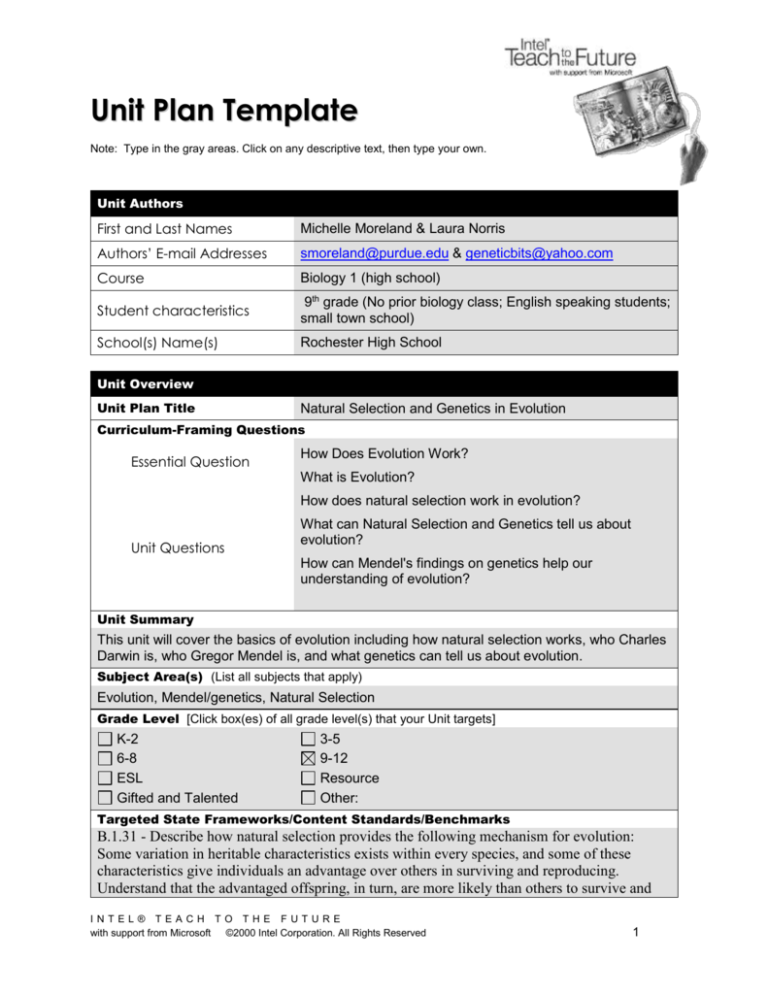
Unit Plan Template
Note: Type in the gray areas. Click on any descriptive text, then type your own.
Unit Authors
First and Last Names
Michelle Moreland & Laura Norris
Authors’ E-mail Addresses
smoreland@purdue.edu & geneticbits@yahoo.com
Course
Biology 1 (high school)
Student characteristics
9th grade (No prior biology class; English speaking students;
small town school)
School(s) Name(s)
Rochester High School
Unit Overview
Unit Plan Title
Natural Selection and Genetics in Evolution
Curriculum-Framing Questions
Essential Question
How Does Evolution Work?
What is Evolution?
How does natural selection work in evolution?
Unit Questions
What can Natural Selection and Genetics tell us about
evolution?
How can Mendel's findings on genetics help our
understanding of evolution?
Unit Summary
This unit will cover the basics of evolution including how natural selection works, who Charles
Darwin is, who Gregor Mendel is, and what genetics can tell us about evolution.
Subject Area(s) (List all subjects that apply)
Evolution, Mendel/genetics, Natural Selection
Grade Level [Click box(es) of all grade level(s) that your Unit targets]
K-2
6-8
ESL
Gifted and Talented
3-5
9-12
Resource
Other:
Targeted State Frameworks/Content Standards/Benchmarks
B.1.31 - Describe how natural selection provides the following mechanism for evolution:
Some variation in heritable characteristics exists within every species, and some of these
characteristics give individuals an advantage over others in surviving and reproducing.
Understand that the advantaged offspring, in turn, are more likely than others to survive and
INTEL® TEACH TO THE FUTURE
with support from Microsoft ©2000 Intel Corporation. All Rights Reserved
1
reproduce. Also understand that the proportion of individuals in the population that have
advantageous characteristics will increase.
B.2.4 - Explain that after the publication of Origin of Species, biological evolution was
supported by the rediscovery of the genetics experiments of an Austrian monk, Gregor
Mendel, by the identification of genes and how they are sorted in reproduction, and by the
discovery that the genetic code found in DNA is the same for almost all organisms.
Student Objectives/Learning Outcomes
Students will be able to explain who Charles Darwin is.
Students will be able to explain what Darwin proposed about Natural Selection.
Students will be able to explain who Gregor Mendel is.
Students will be able to explain how genetics can affect evolution.
Students will demonstrate knowledge of evolution by natural selection through project
presentations.
Procedures
Give broad overview of evolution before going in depth into natural selection and how
genetics is a part of natural selection.
As a fun way to transition into natural selection and improve acceptance attitudes of
students, have them read and consider the “Survival of the Sneakiest” comic.
Begin lesson on Charles Darwin and his contributions to our understanding of natural
selection. This lesson would also discuss natural selection more in depth to give
students a clearer picture of what they should be learning. Also, as a hands-on activity
to help the students understand natural selection, during one of the lectures a candy
dish containing popular and unusual or unpopular candy is passed around the class.
Students should only take one piece each time the bowl passes them. The students
can then see a sort of “natural” selection on the candy – after about 30 minutes the
candy left in the bowl are the pieces that survived.
Transition into discussing Natural Selection in more detail; explaining that it is only one
mechanism of evolution and how it works. An activity to do as part of this section of
the unit is an activity where students “become” finches and draw cards to determine
their beak type and what seeds they need to eat. The activity goes through several
generations with modifications occurring each generation. Both good and bad
modifications can occur.
As an introduction to how natural selection is related to genetics, the students can
watch a video about Pardis Sabeti and discuss what they think it means. Then, it
would be beneficial to explain basic Mendelian genetics, or rather – Mendel’s
experiment, to the students. To further ground the notion of how traits are passed
along through genetics, an activity called “Breeding Bunnies” can be employed.
Finally, wrap up the unit by tying it all together: “What can Natural Selection and
Genetics tell us about Evolution?”
As a presentation project, students will develop a PowerPoint presentation to feature
an example of evolution by natural selection. These projects will be presented to the
entire class so that all students can gain benefit from them.
Approximate Time Needed
2 weeks
Prerequisite Skills
INTEL® TEACH TO THE FUTURE
with support from Microsoft ©2000 Intel Corporation. All Rights Reserved
2
This unit is for 9th grade. No special prerequisites required.
Materials and Resources
Technology – Hardware (Click boxes of all equipment needed)
Camera
Laser Disk
Computer(s)
Printer
Digital Camera
Projection System
DVD Player
Scanner
Internet Connection
Television
VCR
Video Camera
Video Conferencing Equip.
Other:
Technology – Software (Click boxes of all software needed.)
Database/Spreadsheet
Image Processing
Desktop Publishing
Internet Web Browser
E-mail Software
Multimedia
Encyclopedia on CD-ROM
Web Page Development
Word Processing
Other: Powerpoint
Printed
Materials
Handouts for activities
Supplies
Computer, candy, beans, mutation cards,
Internet
Resourc
es
Others
http://anthro.palomar.edu/evolve/evolve_2.htm
http://anthro.palomar.edu/synthetic/synth_4.htm
http://evolution.berkeley.edu/evosite/evo101/IIIENaturalSelection.shtml
http://www.actionbioscience.org/evolution/futuyma.html
http://www.literature.org/authors/darwin-charles/the-origin-ofspecies/chapter-04.html
http://www.mnsu.edu/emuseum/biology/evolution/genetics/mendelsvariatio
n.html
http://www.pbs.org/wgbh/evolution/library/faq/cat01.html#Q01
http://www.rogers.k12.ar.us/users/ehutches/mendel.phtml
None
Accommodations for Differentiated Instruction
Resource Student
Modifications and adaptations will vary based on the
individual student’s IEP.
INTEL® TEACH TO THE FUTURE
with support from Microsoft ©2000 Intel Corporation. All Rights Reserved
3
Non-Native English
Speaker
ESL Students will have the option to have readings
provided at a lower grade level.
If needed, note pages from the teacher's presentation
can be provided.
The teacher will be willing to repeat or rephrase
directions to assist the ESL student in understanding.
Students shall be allowed to go into greater detail on
projects with teacher's OK.
Students may choose to be peer-tutors if they find it
beneficial to their learning.
Students will be given flexibility in project subject
matter.
Gifted Student
Student Assessment
Students will be assessed through provided rubrics for assignments in addition to unit exams
and quizzes.
Page 4 of 4










